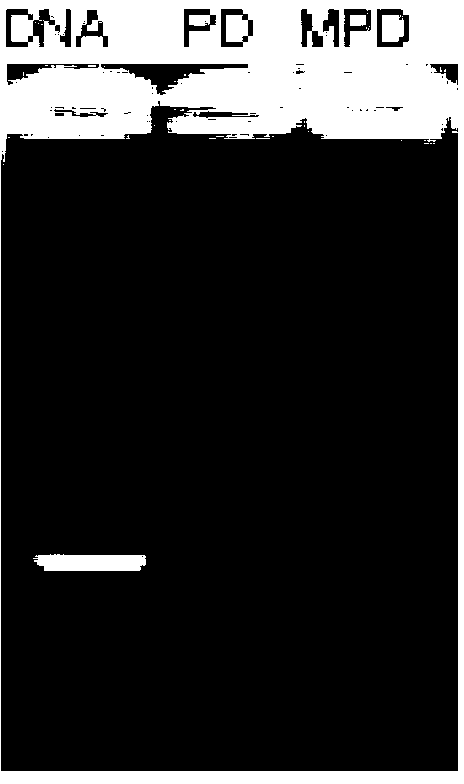Magnetic nanometer gene vector system as well as preparation method and application thereof
A gene carrier, magnetic nanotechnology, applied in gene therapy, the introduction of foreign genetic material using a vector, and other methods of inserting foreign genetic material, etc., can solve the problems affecting the safety of gene transfection effect, high cytotoxicity, etc. Gene transfection efficiency, the effect of reducing cytotoxicity, particle size and surface charge
- Summary
- Abstract
- Description
- Claims
- Application Information
AI Technical Summary
Problems solved by technology
Method used
Image
Examples
Embodiment 1
[0030] A magnetic nanometer gene carrier system is composed of negatively charged magnetic nanoparticles (MNP), a cationic carrier and a gene. The gene carrier system is prepared by the following method:
[0031] The gene was dissolved in sterile water, and the cationic carrier and negatively charged magnetic nanoparticles were dissolved in sterile buffer solution; according to the mass ratio of the cationic carrier to the gene was 0.3:1, the cationic carrier was added to the gene solution, at room temperature Leave it for 8 minutes to obtain the solution binary gene complex; then add negatively charged magnetic nanoparticles into the binary gene complex according to the ratio of iron element to gene mass ratio of 0.2:1 (the average of the magnetic nanoparticles The particle size is 20nm, and the surface potential is
[0032] -25mV), and placed at room temperature for 6 minutes to obtain a three-component magnetic nano-gene carrier system.
Embodiment 2
[0034] A magnetic nanometer gene carrier system is composed of negatively charged magnetic nanoparticles (MNP), a cationic carrier and a gene. The gene carrier system is prepared by the following method:
[0035] The gene was dissolved in sterile water, and the cationic carrier and negatively charged magnetic nanoparticles were dissolved in sterile buffer respectively; according to the mass ratio of the cationic carrier to the gene was 45:1, the gene solution was added to the cationic carrier, at room temperature Place it for 30 minutes to obtain the solution binary gene complex; then add negatively charged magnetic nanoparticles into the binary gene complex according to the ratio of the mass ratio of the iron element to the gene of 10:1 (the average of the magnetic nanoparticles The particle size is 50nm, and the surface potential is
[0036] -48mV), and placed at room temperature for 25 minutes to obtain a ternary magnetic nano-gene carrier system.
Embodiment 3
[0038] A magnetic nanometer gene carrier system is composed of negatively charged magnetic nanoparticles (MNP), a cationic carrier and a gene. The gene carrier system is prepared by the following method:
[0039]The gene was dissolved in sterile water, and the cationic carrier and negatively charged magnetic nanoparticles were dissolved in sterile buffer respectively (the average particle diameter of the magnetic nanoparticles was 12nm, and the surface potential was -18mV); The mass ratio of the iron element to the gene is 12:1, and the cationic carrier is added to the negatively charged magnetic nanoparticles, and left at room temperature for 18 minutes to obtain a binary complex; Add the gene solution into the binary complex, and place it at room temperature for 12 minutes to obtain a ternary magnetic nano-gene carrier system.
PUM
| Property | Measurement | Unit |
|---|---|---|
| particle size | aaaaa | aaaaa |
| particle size | aaaaa | aaaaa |
| particle size | aaaaa | aaaaa |
Abstract
Description
Claims
Application Information
 Login to View More
Login to View More - R&D
- Intellectual Property
- Life Sciences
- Materials
- Tech Scout
- Unparalleled Data Quality
- Higher Quality Content
- 60% Fewer Hallucinations
Browse by: Latest US Patents, China's latest patents, Technical Efficacy Thesaurus, Application Domain, Technology Topic, Popular Technical Reports.
© 2025 PatSnap. All rights reserved.Legal|Privacy policy|Modern Slavery Act Transparency Statement|Sitemap|About US| Contact US: help@patsnap.com



